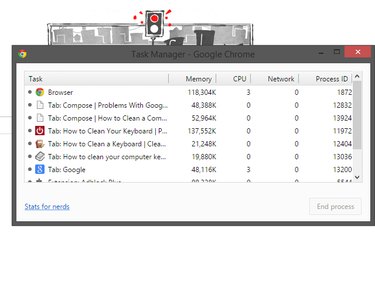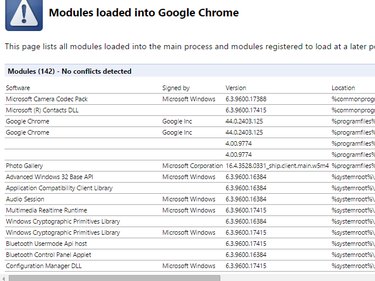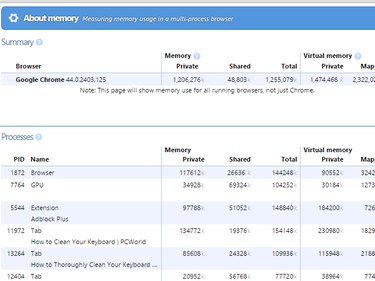Most errors that occur in Google Chrome can be fixed with a reload or settings changes. When an error occurs in Chrome, the first and most important step is to correctly identify the problem. Once you know what's going on, addressing the problem is generally much easier. Keeping Chrome and your extensions up-to-date can often help with bugs and issues within Chrome.
Web Page Crashes
Video of the Day
The "Aw, Snap!" error is one of the most common encountered, and occurs when a Web page doesn't load correctly or crashes unexpectedly. Typically the best solution is to reload the page, or restart Chrome and try the page again. If reloading or restarting doesn't help, your anti-virus or firewall apps may be blocking the site, or your extensions may not be working correctly with content on the page.
Video of the Day
Plugin Crashes

Plugins add features to Chrome, such as support for Flash video and animation or online viewing of PDF documents. However, sometimes a plugin crashes, especially since Chrome no longer supports NPAPI plugins like Silverlight, Java and Unity. When a plugin crashes, try reloading the page to restart it. Sometimes plugins restart on their own, or you have to forcibly close the process using Chrome's in-app task manager.
Browser Crashes

When Chrome unexpectedly shuts down, you receive the "Whoa! Google Chrome has crashed." error message. There are a number of causes for browser crashes, including software conflicts, corrupted user profiles and insufficient memory to maintain the program.
Before you do anything else, restart Chrome and see if the crash occurs again. If it does, type about:conflicts in the address bar and see if any program conflicts are listed. Closing out any conflicting programs can often resolve the issue, as can reducing memory usage in the case of insufficient memory.
If Chrome doesn't launch at all, try restarting your computer and check your firewall and anti-virus software to see if Chrome is blocked. You can also use the Chrome Cleanup Tool to try and address problems with Chrome not launching. If all else fails, resetting Chrome to its original defaults may help.
Corrupted User Profile
A corrupted user profile accounts for many instances of crashing, hanging and similar errors in which Chrome no longer works. If you suspect your user profile is to blame for problems with Chrome, try creating a new user profile and using it while browsing. If you don't encounter any further problems, the old profile was likely the issue.
Web Page Display Errors
There are many possible reasons that a website might not load properly in Chrome, or why certain elements don't render properly -- this also means there are a lot of possible solutions.
Start by trying the website in Chrome's Incognito mode, which doesn't save browsing history. If the website works fine, the source of your problem may be your cache, browsing history or extensions. Clear your cache and browsing history to see if that resolves the problem. If not, try disabling each of your extensions one at a time to see if one of them is causing the problem.
If graphics like video, pictures or 3D imagery aren't running properly, you may need to update your graphics card drivers.
Installation or Update Errors
Some errors can occur when Chrome updates. Most errors are coded to convey the problem. For example, error code 7 means that Chrome downloaded an update but couldn't properly install it, while error codes 11, 102 and 103 all indicate that a necessary Windows component called expand.exe is missing. In most cases, installation and update errors can be fixed by restarting your computer or downloading a different installation package from Google. In some cases, you may have to uninstall and then reinstall Chrome.
Memory Usage

Chrome can use a lot of your available memory during a session, especially if you have several open tabs or extensions. If you've ever gotten the "He's Dead, Jim!" error message, it means your computer closed a tab process because of insufficient memory. This message also occurs if you stop a process using Chrome's in-app Task Manager.
Memory problems can also result in sluggish performance, making Chrome less convenient to use. If Chrome is experiencing memory problems, close out any other unnecessary programs on your computer and close all unused tabs. If that doesn't help, restart your computer. If the problem persists, reset Chrome to its default settings.